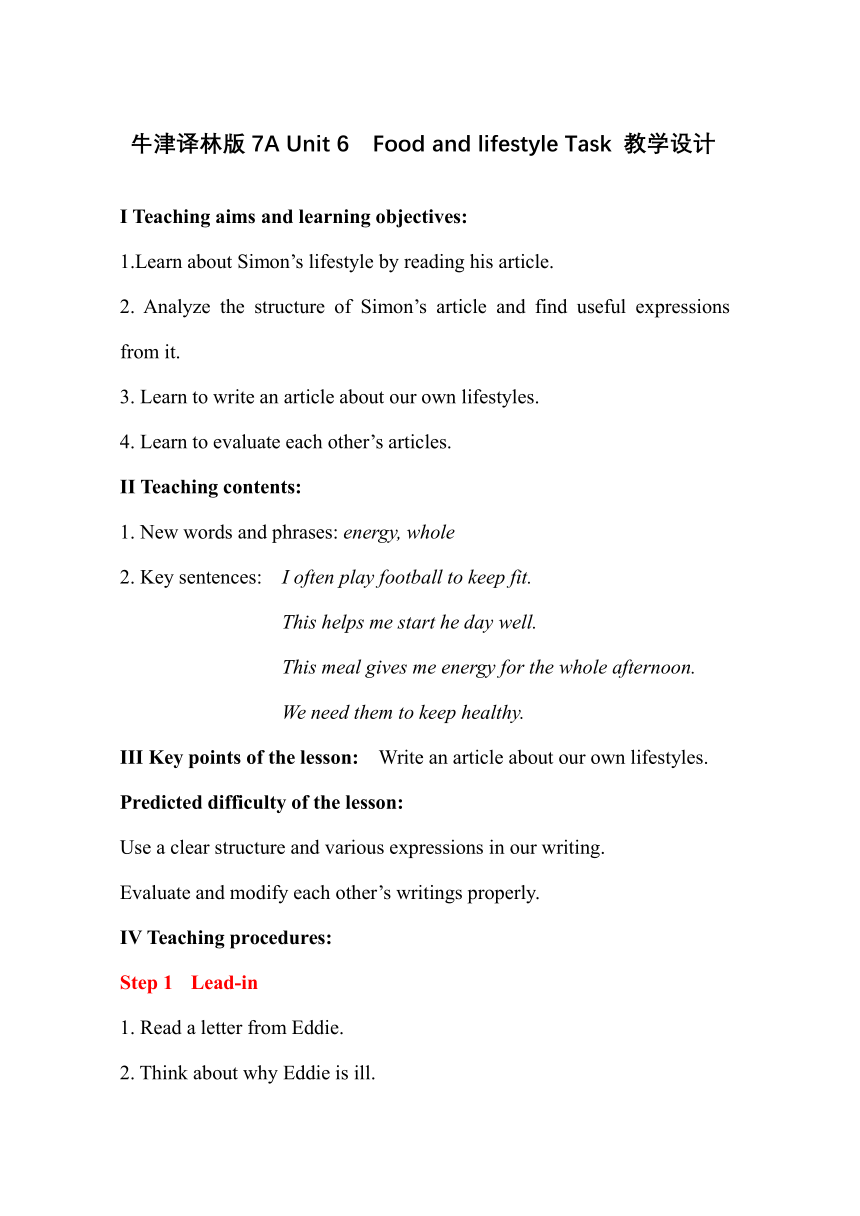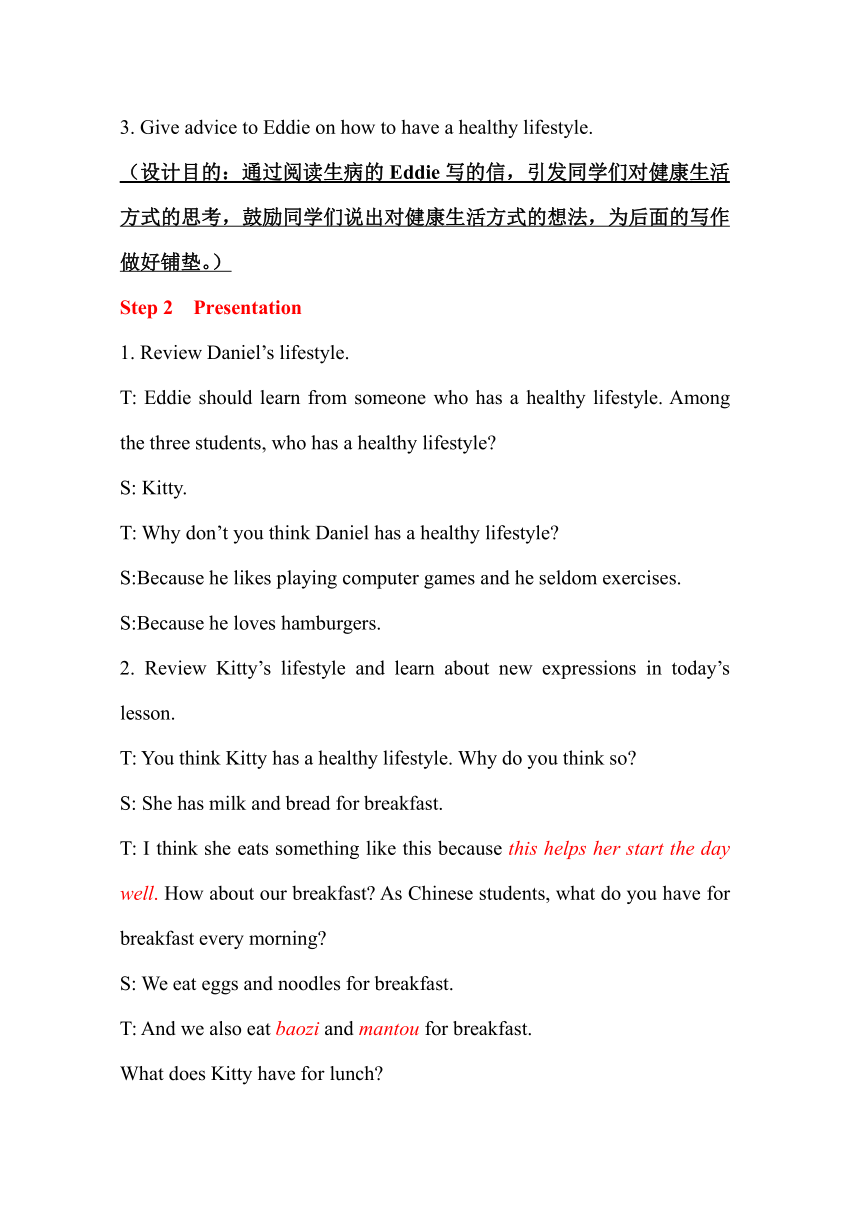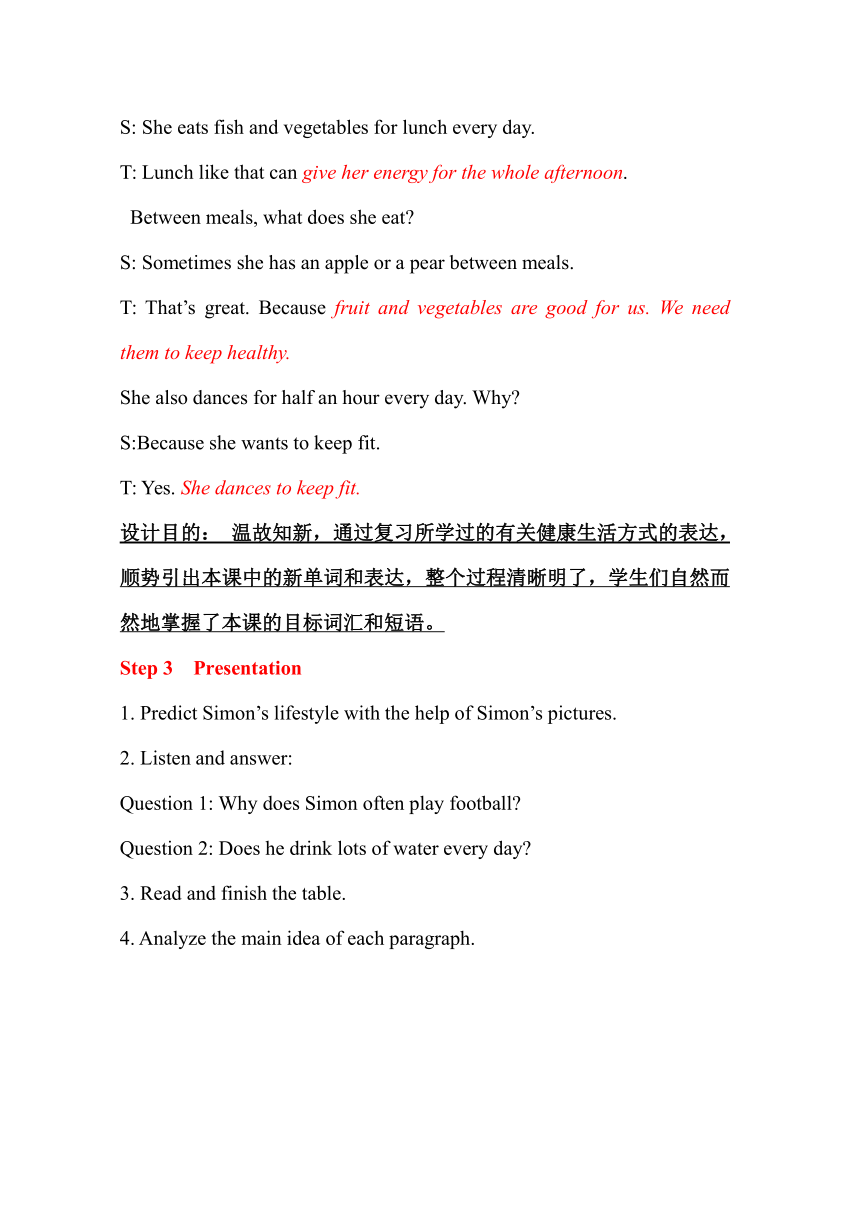Unit 6 Task Healthy lifestyle 教案
文档属性
| 名称 | Unit 6 Task Healthy lifestyle 教案 |  | |
| 格式 | doc | ||
| 文件大小 | 203.5KB | ||
| 资源类型 | 教案 | ||
| 版本资源 | 牛津译林版 | ||
| 科目 | 英语 | ||
| 更新时间 | 2022-06-21 09:41:48 | ||
图片预览



文档简介
牛津译林版7A Unit 6 Food and lifestyle Task 教学设计
I Teaching aims and learning objectives:
1.Learn about Simon’s lifestyle by reading his article.
2. Analyze the structure of Simon’s article and find useful expressions from it.
3. Learn to write an article about our own lifestyles.
4. Learn to evaluate each other’s articles.
II Teaching contents:
1. New words and phrases: energy, whole
2. Key sentences: I often play football to keep fit.
This helps me start he day well.
This meal gives me energy for the whole afternoon.
We need them to keep healthy.
III Key points of the lesson: Write an article about our own lifestyles.
Predicted difficulty of the lesson:
Use a clear structure and various expressions in our writing.
Evaluate and modify each other’s writings properly.
IV Teaching procedures:
Step 1 Lead-in
1. Read a letter from Eddie.
2. Think about why Eddie is ill.
3. Give advice to Eddie on how to have a healthy lifestyle.
(设计目的:通过阅读生病的Eddie写的信,引发同学们对健康生活方式的思考,鼓励同学们说出对健康生活方式的想法,为后面的写作做好铺垫。)
Step 2 Presentation
1. Review Daniel’s lifestyle.
T: Eddie should learn from someone who has a healthy lifestyle. Among the three students, who has a healthy lifestyle
S: Kitty.
T: Why don’t you think Daniel has a healthy lifestyle
S:Because he likes playing computer games and he seldom exercises.
S:Because he loves hamburgers.
2. Review Kitty’s lifestyle and learn about new expressions in today’s lesson.
T: You think Kitty has a healthy lifestyle. Why do you think so
S: She has milk and bread for breakfast.
T: I think she eats something like this because this helps her start the day well. How about our breakfast As Chinese students, what do you have for breakfast every morning
S: We eat eggs and noodles for breakfast.
T: And we also eat baozi and mantou for breakfast.
What does Kitty have for lunch
S: She eats fish and vegetables for lunch every day.
T: Lunch like that can give her energy for the whole afternoon.
Between meals, what does she eat
S: Sometimes she has an apple or a pear between meals.
T: That’s great. Because fruit and vegetables are good for us. We need them to keep healthy.
She also dances for half an hour every day. Why
S:Because she wants to keep fit.
T: Yes. She dances to keep fit.
设计目的: 温故知新,通过复习所学过的有关健康生活方式的表达,顺势引出本课中的新单词和表达,整个过程清晰明了,学生们自然而然地掌握了本课的目标词汇和短语。
Step 3 Presentation
1. Predict Simon’s lifestyle with the help of Simon’s pictures.
2. Listen and answer:
Question 1: Why does Simon often play football
Question 2: Does he drink lots of water every day
3. Read and finish the table.
4. Analyze the main idea of each paragraph.
4. Find out useful expressions from the article.
(设计目的:层层递进、逐步深入地阅读范文,引导同学们自主分析出文章的结构,发现并积累文章中精炼的表达,为接下来的自主写作做进一步的铺垫。)
Step 4 Writing
1. Pre-writing
(1)Talk about our lifestyles in pairs.
(2)Write the outlines of our articles before writing.
(3)Learn to use different expressions in our writings.
(4) Learn to add a good ending to our articles.
(5) Pay attention to details according to the evaluation form.
2. While-writing.
3. After-writing.
(1) Check your writing by yourself first.
(2) Check your writings in pairs.
(3) Show your writing to us.
(设计目的:先进行口头输出,谈论各自的生活方式,再进入写作部分,这种过渡的方式让学生面对写作任务时,不再手足无措,而是胸有成竹,“有话可写”。在正式写作前,鼓励学生先构思,写好提纲,再动笔,养成良好的写作习惯。同时,通过举例的方式,让学生学习到更多的写作技巧,如鼓励学生采用丰富的表达,完善文章的结构,并且关注写作中的语言细节,尽可能避免错误的出现。这些写作技能的训练有助于学生增加对写作的兴趣,提高学生的写作水平。)
Step 5 Summary
1. Summarize some writing skills.
2. Learn to enjoy a healthy lifestyle.
Homework
1.Polish(润色) your writing and hand it in.
2. Write an article about your deskmate’s or your friend’s lifestyle.
2.Search for more information about a healthy lifestyle.
教后记:这是一节读写课,读是写的铺垫与基础,写是读的展示与升华。整节课的设计紧密围绕着“读写”这一核心,先让学生逐步把范文读得透彻,分析出文章的结构,积累到文章中的佳句,再帮助学生运用丰富的写作技巧来完成自己的写作,最后再鼓励学生自评、互评文章,促进学生之间互相学习。
这种扎扎实实“搭梯子”的教学方式,实现了本节课的教学目标,帮助学生读懂了范文并写出了自己的文章。但是前面的铺垫部分过多,导致“读”的部分过多,“写”和“评”的部分不足,这就让学生在45分钟课堂中的收获不如预期。前面的导入部分可以更简洁,直接建议Eddie向Kitty学习,然后进入本课的语言教学,进而进入本节课的读写部分,这样就会给后面互相评价的环节留出更多的时间,写作课的意义就更明显、更深入了。
没有完美的课,因此需要在每节课后进行更深入的思考,让下一节课里的师生有着更多的收获和更高的学习效率。
I Teaching aims and learning objectives:
1.Learn about Simon’s lifestyle by reading his article.
2. Analyze the structure of Simon’s article and find useful expressions from it.
3. Learn to write an article about our own lifestyles.
4. Learn to evaluate each other’s articles.
II Teaching contents:
1. New words and phrases: energy, whole
2. Key sentences: I often play football to keep fit.
This helps me start he day well.
This meal gives me energy for the whole afternoon.
We need them to keep healthy.
III Key points of the lesson: Write an article about our own lifestyles.
Predicted difficulty of the lesson:
Use a clear structure and various expressions in our writing.
Evaluate and modify each other’s writings properly.
IV Teaching procedures:
Step 1 Lead-in
1. Read a letter from Eddie.
2. Think about why Eddie is ill.
3. Give advice to Eddie on how to have a healthy lifestyle.
(设计目的:通过阅读生病的Eddie写的信,引发同学们对健康生活方式的思考,鼓励同学们说出对健康生活方式的想法,为后面的写作做好铺垫。)
Step 2 Presentation
1. Review Daniel’s lifestyle.
T: Eddie should learn from someone who has a healthy lifestyle. Among the three students, who has a healthy lifestyle
S: Kitty.
T: Why don’t you think Daniel has a healthy lifestyle
S:Because he likes playing computer games and he seldom exercises.
S:Because he loves hamburgers.
2. Review Kitty’s lifestyle and learn about new expressions in today’s lesson.
T: You think Kitty has a healthy lifestyle. Why do you think so
S: She has milk and bread for breakfast.
T: I think she eats something like this because this helps her start the day well. How about our breakfast As Chinese students, what do you have for breakfast every morning
S: We eat eggs and noodles for breakfast.
T: And we also eat baozi and mantou for breakfast.
What does Kitty have for lunch
S: She eats fish and vegetables for lunch every day.
T: Lunch like that can give her energy for the whole afternoon.
Between meals, what does she eat
S: Sometimes she has an apple or a pear between meals.
T: That’s great. Because fruit and vegetables are good for us. We need them to keep healthy.
She also dances for half an hour every day. Why
S:Because she wants to keep fit.
T: Yes. She dances to keep fit.
设计目的: 温故知新,通过复习所学过的有关健康生活方式的表达,顺势引出本课中的新单词和表达,整个过程清晰明了,学生们自然而然地掌握了本课的目标词汇和短语。
Step 3 Presentation
1. Predict Simon’s lifestyle with the help of Simon’s pictures.
2. Listen and answer:
Question 1: Why does Simon often play football
Question 2: Does he drink lots of water every day
3. Read and finish the table.
4. Analyze the main idea of each paragraph.
4. Find out useful expressions from the article.
(设计目的:层层递进、逐步深入地阅读范文,引导同学们自主分析出文章的结构,发现并积累文章中精炼的表达,为接下来的自主写作做进一步的铺垫。)
Step 4 Writing
1. Pre-writing
(1)Talk about our lifestyles in pairs.
(2)Write the outlines of our articles before writing.
(3)Learn to use different expressions in our writings.
(4) Learn to add a good ending to our articles.
(5) Pay attention to details according to the evaluation form.
2. While-writing.
3. After-writing.
(1) Check your writing by yourself first.
(2) Check your writings in pairs.
(3) Show your writing to us.
(设计目的:先进行口头输出,谈论各自的生活方式,再进入写作部分,这种过渡的方式让学生面对写作任务时,不再手足无措,而是胸有成竹,“有话可写”。在正式写作前,鼓励学生先构思,写好提纲,再动笔,养成良好的写作习惯。同时,通过举例的方式,让学生学习到更多的写作技巧,如鼓励学生采用丰富的表达,完善文章的结构,并且关注写作中的语言细节,尽可能避免错误的出现。这些写作技能的训练有助于学生增加对写作的兴趣,提高学生的写作水平。)
Step 5 Summary
1. Summarize some writing skills.
2. Learn to enjoy a healthy lifestyle.
Homework
1.Polish(润色) your writing and hand it in.
2. Write an article about your deskmate’s or your friend’s lifestyle.
2.Search for more information about a healthy lifestyle.
教后记:这是一节读写课,读是写的铺垫与基础,写是读的展示与升华。整节课的设计紧密围绕着“读写”这一核心,先让学生逐步把范文读得透彻,分析出文章的结构,积累到文章中的佳句,再帮助学生运用丰富的写作技巧来完成自己的写作,最后再鼓励学生自评、互评文章,促进学生之间互相学习。
这种扎扎实实“搭梯子”的教学方式,实现了本节课的教学目标,帮助学生读懂了范文并写出了自己的文章。但是前面的铺垫部分过多,导致“读”的部分过多,“写”和“评”的部分不足,这就让学生在45分钟课堂中的收获不如预期。前面的导入部分可以更简洁,直接建议Eddie向Kitty学习,然后进入本课的语言教学,进而进入本节课的读写部分,这样就会给后面互相评价的环节留出更多的时间,写作课的意义就更明显、更深入了。
没有完美的课,因此需要在每节课后进行更深入的思考,让下一节课里的师生有着更多的收获和更高的学习效率。
同课章节目录
- 预备课程
- Lesson 1 Nice to meet you !
- Lesson 2 A happy family
- Lesson 3 A nice school
- Lesson 4 You look cool !
- Lesson 5 Wonderful things
- Lesson 6 Have nice food
- Lesson 7 Enjoy our days
- Lesson 8 Let's have fun !
- Unit 1 This is me
- Unit 2 Let's play sports
- Unit 3 Welcome to our school
- Unit 4 My day
- Unit 5 Let’s celebrate
- Unit 6 Food and lifestyle
- Unit 7 Shopping
- Unit 8 Fashion
